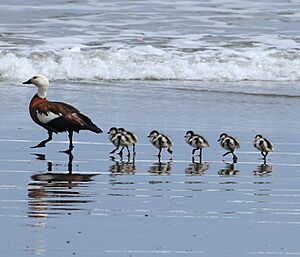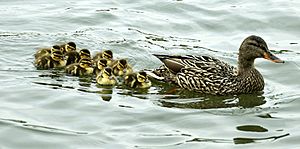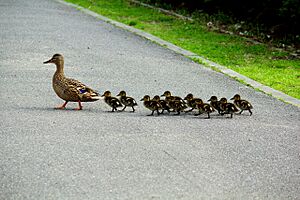Imprinting facts for kids


Imprinting is a special kind of fast learning that happens in animals. It's like a quick lesson that sticks with them for life!
This learning usually happens very early in an animal's life. Scientists call this a critical period. It means there's a specific age or stage when this learning can happen. During this time, the animal learns to recognize a certain signal, like a sound or a sight. This signal then becomes 'imprinted' in their memory. This whole process is guided by an inherited instinct.
Contents
What is Imprinting?
The most famous example of imprinting is when baby birds, like ducks or geese, learn who their parents are right after hatching. This helps the young stay close to their parents. It's super important for their safety and for learning how to survive. You often see ducklings following their mother in a perfect line, whether on land or in water.
Who Discovered Imprinting?
The idea of imprinting was first noticed in chickens in the 1800s by a scientist named Douglas Spalding. Later, two famous animal behavior scientists, Oskar Heinroth and his student Konrad Lorenz, studied it more deeply. Another scientist, Niko Tinbergen, also helped us understand imprinting better.
Konrad Lorenz's Experiments
Konrad Lorenz did many experiments with geese. He showed that goslings (baby geese) would imprint on the first moving thing they saw within 13 to 16 hours after hatching. For example, if Lorenz was the first thing they saw, they would follow him! He often took pictures with a group of geese following him around, thinking he was their parent.
Imprinting in Humans
In child development, imprinting also plays a role. It helps a baby learn to recognize its mother and father. This process actually starts even before birth! Babies in the womb can begin to recognize their parents' voices.
Imprinting in Movies
Imprinting was even used to make the movie Winged Migration. This movie shows amazing footage of migratory birds flying. To film this, the birds imprinted on the movie handlers. These handlers wore yellow jackets and made honking sounds. The birds then learned to fly alongside different aircraft, like ultralight planes, making it possible to film them up close.



